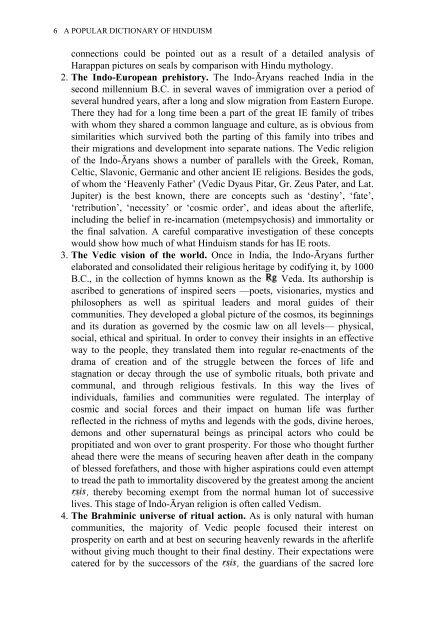You also want an ePaper? Increase the reach of your titles
YUMPU automatically turns print PDFs into web optimized ePapers that Google loves.
6 A POPULAR DICTIONARY OF HINDUISM<br />
connections could be pointed out as a result <strong>of</strong> a detailed analysis <strong>of</strong><br />
Harappan pictures on seals by comparison with Hindu mythology.<br />
2. The Indo-European prehistory. The Indo-Āryans reached India in the<br />
second millennium B.C. in several waves <strong>of</strong> immigration over a period <strong>of</strong><br />
several hundred years, after a long and slow migration from Eastern Europe.<br />
There they had for a long time been a part <strong>of</strong> the great IE family <strong>of</strong> tribes<br />
with whom they shared a common language and culture, as is obvious from<br />
similarities which survived both the parting <strong>of</strong> this family into tribes and<br />
their migrations and development into separate nations. The Vedic religion<br />
<strong>of</strong> the Indo-Āryans shows a number <strong>of</strong> parallels with the Greek, Roman,<br />
Celtic, Slavonic, Germanic and other ancient IE religions. Besides the gods,<br />
<strong>of</strong> whom the ‘Heavenly Father’ (Vedic Dyaus Pitar, Gr. Zeus Pater, and Lat.<br />
Jupiter) is the best known, there are concepts such as ‘destiny’, ‘fate’,<br />
‘retribution’, ‘necessity’ or ‘cosmic order’, and ideas about the afterlife,<br />
including the belief in re-incarnation (metempsychosis) and immortality or<br />
the final salvation. A careful comparative investigation <strong>of</strong> these concepts<br />
would show how much <strong>of</strong> what <strong>Hinduism</strong> stands for has IE roots.<br />
3. The Vedic vision <strong>of</strong> the world. Once in India, the Indo-Āryans further<br />
elaborated and consolidated their religious heritage by codifying it, by 1000<br />
B.C., in the collection <strong>of</strong> hymns known as the Veda. Its authorship is<br />
ascribed to generations <strong>of</strong> inspired seers —poets, visionaries, mystics and<br />
philosophers as well as spiritual leaders and moral guides <strong>of</strong> their<br />
communities. They developed a global picture <strong>of</strong> the cosmos, its beginnings<br />
and its duration as governed by the cosmic law on all levels— physical,<br />
social, ethical and spiritual. In order to convey their insights in an effective<br />
way to the people, they translated them into regular re-enactments <strong>of</strong> the<br />
drama <strong>of</strong> creation and <strong>of</strong> the struggle between the forces <strong>of</strong> life and<br />
stagnation or decay through the use <strong>of</strong> symbolic rituals, both private and<br />
communal, and through religious festivals. In this way the lives <strong>of</strong><br />
individuals, families and communities were regulated. The interplay <strong>of</strong><br />
cosmic and social forces and their impact on human life was further<br />
reflected in the richness <strong>of</strong> myths and legends with the gods, divine heroes,<br />
demons and other supernatural beings as principal actors who could be<br />
propitiated and won over to grant prosperity. For those who thought further<br />
ahead there were the means <strong>of</strong> securing heaven after death in the company<br />
<strong>of</strong> blessed forefathers, and those with higher aspirations could even attempt<br />
to tread the path to immortality discovered by the greatest among the ancient<br />
, thereby becoming exempt from the normal human lot <strong>of</strong> successive<br />
lives. This stage <strong>of</strong> Indo-Āryan religion is <strong>of</strong>ten called Vedism.<br />
4. The Brahminic universe <strong>of</strong> ritual action. As is only natural with human<br />
communities, the majority <strong>of</strong> Vedic people focused their interest on<br />
prosperity on earth and at best on securing heavenly rewards in the afterlife<br />
without giving much thought to their final destiny. Their expectations were<br />
catered for by the successors <strong>of</strong> the , the guardians <strong>of</strong> the sacred lore


















